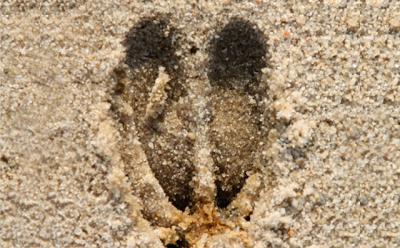Nature Notes: Halt! Who Goes There?

On Saturday morning when Friday’s snow had just begun to melt, I went on Eileen Schwinn’s annual Morton Wildlife Refuge bird walk under the auspices of the East End Audubon Society. It was cold but sunny and pleasant, and as we walked down to the bay along that well-trodden trail that ultimately leads to Jessup’s Point, chickadees, titmice, cardinals, and an occasional nuthatch begged for seeds and my 10 or so fellow walkers would stop to oblige them.
There was enough snow to read the tracks, and those of turkeys, rabbits, squirrels, and the occasional fox stood out clearly. Our tracks obliterated many of the others but only on the trails, which we kept to. Reading and comparing tracks got me thinking: Ours were flatfooted, clearly showing the tread pattern on the soles of our hiking footwear; those of non-humans showed not tread, but instead, claws, pads, and the like. The red fox and the turkey tracks stood out; both animals tend to walk in a very straight line, and in the case of the former, one rear paw fits neatly into the track made by the forepaw so that the line of tracks immediately says “red fox.” Dogs and other canines are not that meticulous in their gaits.
Humans and other primates have plantigrade feet that meet the ground with both heal and forefoot simultaneously, especially when standing. Cottontail rabbits, gray squirrels, raccoons, bears, and even kangaroos are also plantigrade. Such mammals can stand upright for longer periods of time and with more stability, which allows them to use their hands and forepaws for manipulating things like food and tools.
All rodents are plantigrade. The ubiquitous gray squirrel has plantigrade feet, as does the woodchuck, but it can use its tail as a prop to increase its balance while using its forepaws to do some housekeeping.
Dogs, foxes, cats, and other mammals that have forefeet that are identical to hind feet in size and shape have digitigrade stances and gaits, meaning that their heels are raised and never touch the ground while standing or running. They can’t use their forefeet the way raccoons and humans can, but they can run very fast if need be and spring high into the air. Except for a few, like the leopard, they can’t climb trees and swing from limb to limb.
Most rodents — mice, rats, squirrels, rabbits, prairie dogs, chipmunks, and the like — lay down symmetrical pairs of tracks. Tracks of the forepaws are usually smaller than those of the hind paws, especially in cottontails, jackrabbits, and snowshoe hares. Thus, when you see two pairs of paw prints, one behind the other, in the snow, you know you have a rodent. Those of mice are similar to those of squirrels but much, much smaller.
We saw a lot of deer tracks during our walk. Young of the year leave smaller tracks than adults. Deer, horses, cows, and other ungulates run on their fore toes, which are crafted into hooves. In horses, the fore toes are welded together. In deer, the two are separated so you see two side-by-side marks each time the foot makes contact with the snow. Like digitigrades, they can also run very fast and are very good jumpers.
Adult turkey tracks are very large, a good four inches back to front, side to side. The heel, or tarsus, of birds is part of the leg bone that stems from the knee. Turkeys and the flightless ratites — ostriches, rheas, emus, and cassowaries — can run very fast, with one foot down ahead of the other like deer and dogs. Herons, shorebirds, crows, grackles, and quail walk and run in the same manner. Walking birds with long tails such as pheasants often accompany their footprints with tail-drag lines.
Penguins are not ratites but are also flightless, as was the extinct dodo. They use their wings to propel them through the water. When on land, they walk the way we do but take very, very tiny steps. Single-stepping birds that can fly often run a bit before taking off, the way grebes and loons run across the surface of the water before flying.
Almost all songbirds hop when moving over the ground. Thus they leave pairs of side-by-side tracks, which could be confused with tracks left by a mouse, but instead of a cluster of four, two slightly smaller than the other two, they are laid down in single pairs only. They can put one foot after another if need be, but almost never do. When taking off, they hop into the air while simultaneously flapping their wings.
Red-winged blackbirds were singing, robins were calling, geese were courting, but the most prominent sign of the coming spring on our walk through the refuge was the adult chipmunk, which popped out time and again from a little hollow in the bottom of a standing tree trunk to take sunflower seeds thrown its way. Such an early emergence from winter sleep by chipmunks is almost becoming commonplace in this millennium. One wonders if it is a sign of global warming or just another anomaly?
Larry Penny can be reached via email at [email protected].
